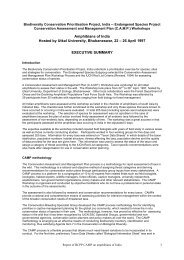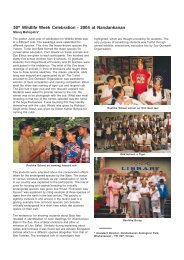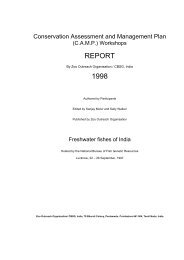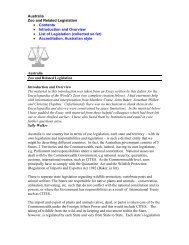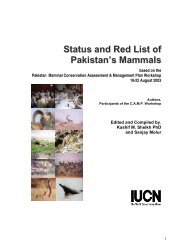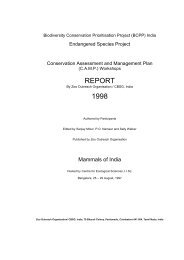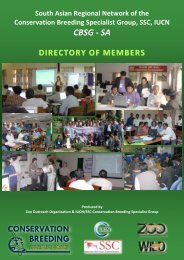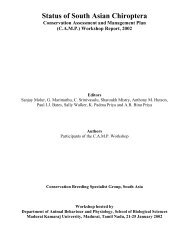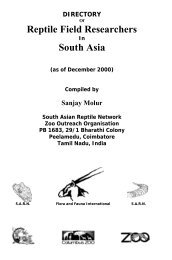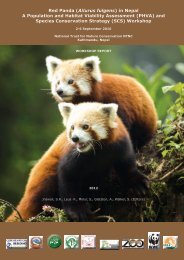Bugs R all March 2011 FINAL daniel - Zoo Outreach Organisation
Bugs R all March 2011 FINAL daniel - Zoo Outreach Organisation
Bugs R all March 2011 FINAL daniel - Zoo Outreach Organisation
- No tags were found...
Create successful ePaper yourself
Turn your PDF publications into a flip-book with our unique Google optimized e-Paper software.
Family HydrophilidaeAmphiops pedestris Sharp1890, Amphiops pedestris Sharp, Trans. Ent. Soc. Lond.,: 354. Type-‐locality: Not KnownMaterial examined: 1 ex, Bibhu,bhusan Wild Life Sanctu-ary, Parmadan, North 24 Parganas district, 11.01.2008, coll. B. Mitra.Distribu^on : India: Pondicherry, Tamil Nadu, West BengalElsewhere: Sri Lanka, Sumatra; Saigon.ReferencesBrancucci, M. 1983. Revision des especes est – palearc3ques, Orientales et australiennes du genge Laccophilus, Ent. Arb. Mus. Frey 31/32, p.241-‐426.Biswas, S & Mukhopadhyay, P.1995, Coleoptera: pp.113-‐176. In Fauna of West Bengal. State of Fauna Ser., 3(6). <strong>Zoo</strong>logical Survey of India, Kolkata, p.143-‐168.Vazirani T.G., 1977, Catalogue of Onital Dy3scidae, Ind. Records of the <strong>Zoo</strong>logical Survey of India Miscellaneous publica3on, Occa-sional paper No.6, p.1-‐111.AcknowledgementsThe authors would like to thank Dr. Ramakrishna, Director, <strong>Zoo</strong>logical Survey of India for the necessary facili,es and encouragement. Thanks are also due to Dr. T. K. Pal and Dr. A. Bal, Scien,st-‐E, and in-‐charge of entomology division (A & B) for kindly going through the manuscript and making useful sugges,ons.DistribuEon and diversity of spiders in agroecosystems of Tirunelveli and Thoothukudi districts of Tamil Nadu, India K. Sahayaraj and S. Jeya ParvathiCrop Protection Research Centre, St. Xavier’s College, Palayamkottai, Tamil Nadu 627002, IndiaEmail: ksraj@sancharnet.inThere are more than 3694 genera and 40,462 spider spe-cies have been recognized <strong>all</strong> over the world (Platnick, 2008). Recent reports show that the number of spider species reported so far from south Asia is 2299 belonging to 552 genera of 67 families (Manju Siliwal and Sanjay Mo-lur, 2007). Spiders play an important role in regula,ng insect pests in agricultural ecosystems. In India, studies on the popula,on and abundance of the spider assemblages in agricultural crops are limited. Pathak and Saha (1999), BhaIacharya (2000), Sebas,an et al., (2005) Bhatnagar et al., (1983) carried out some basic studies about the distri-bu,on of spiders in agroecosystems. Groundnut, Arachis hypogaea (Lin.) was introduced in In-dia about 350 years ago and now it has become one of the important cash crops of India (Khatana et al., 2001), par-‐,cularly for sm<strong>all</strong>-‐scale farmers in semi-‐arid regions of India (FAO, 2001). According to Sahayaraj and Raju (2003) groundnut is being infested by more than 100 species of insects. Recent studies (Nandagopal and Ranga Rao, 2008) showed that more than 180 species of insects and mites have been reported to infest groundnut. Among various spider families reported, Thomisidae, Clubionidae and Araneidae species have been reported from groundnut cul,va,on (Bhatnagar et al., 1983).A detailed study on the popula,on buildup of the spiders and pests are an utmost necessity for the successful crop produc,on and also a prerequisite. Furthermore, informa-‐,on of natural enemies in an area is very essen,al for the successful crop protec,on. However informa,on is lacking in Southern districts of Tamil Nadu par,cularly in Ti-runelveli and Thoothukudi groundnut agroecosystems and therefore, considered desirable to study the spiders and the insect-‐pests in Tirunelveli and Thoothukudi Districts, Tamil Nadu, India from 2003 to 2005.Materials and MethodsField survey was conducted form 2003 to 2005 in two dif-ferent seasons viz., summer (February-‐May) and Kharif (June-‐August) at Tirunelveli and Thoothukudi, Tamil Nadu, India. Four villages were randomly selected from each district for this study. In each village 1 ha of land was con-sidered as an experimental field. A sweep net was used for collec,ng sm<strong>all</strong> size and fast moving spiders. Slow moving spiders were collected using fine camel hairbrush or fine forceps. ResultsThe collec,on yielded 31 spider species belonging to nine families and 18 genera (Table 1). Among the nine families, Oxyopidae (25.81) represented maximum number of spe-cies followed by Araneidae (22.58%), Lycosidae (19.35%), Sal,cidae (12.90%) and Gnaphosidae (06.45%). The family, Amaurobiidae, Eresidae, Theridiidae and Heteropodiidae yielded the least number of species (03.23%). Thirteen species were recorded uniformly in studied groundnut fields from two districts of Tamil Nadu.<strong>Bugs</strong> R A! No. 17 <strong>March</strong> <strong>2011</strong> 10



